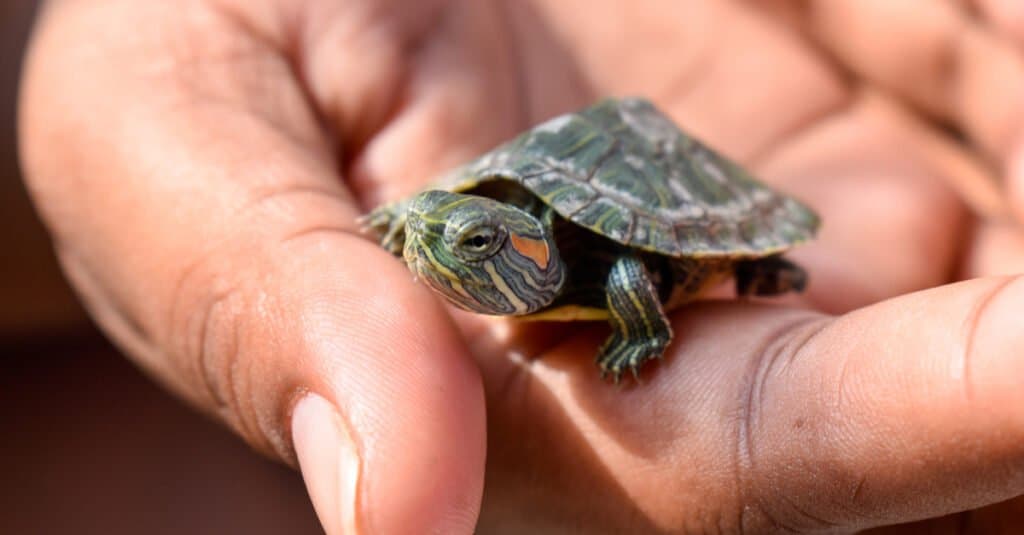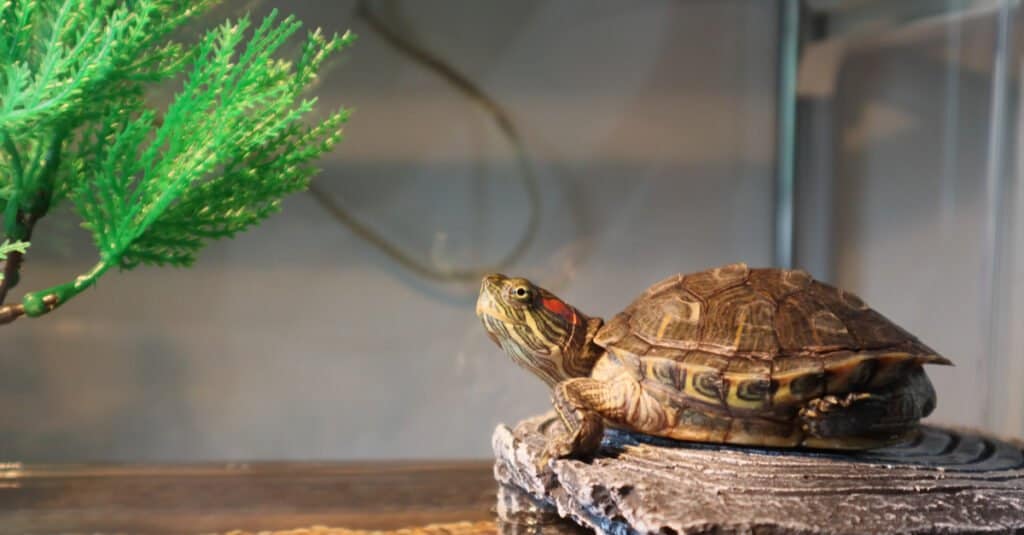As both a highly invasive species and a wildly popular pet amongst reptile hobbyists, red-eared sliders are everywhere! Whether you’re caring for a red-eared slider as a pet or just have a few hanging out in your backyard, it can be helpful to know the average lifespan of these unique turtles and what sort of factors affect how long they live.
Let’s take an in-depth look at how long the typical red-eared slider lives in the wild and in captivity below. I’ll also cover what you can do to ensure your slider lives as long as possible and why turtles in captivity tend to have longer lifespans than their wild counterparts.
How Long Do Red-Eared Sliders Live in the Wild?

Baby red-eared sliders are vulnerable in the wild, but they grow very quickly!
©Akash Naik/Shutterstock.com
Wild red-eared sliders typically live for around 10 to 20 years on average. This estimate is notably a bit lower than the approximate lifespan for sliders kept in captivity.
This is partially because turtles in the wild experience more environmental stressors than captive turtles, including predation, competition amongst themselves and other species for resources, and a higher rate of illnesses, injuries, and parasite infestations. Many invasive species also have shortened lifespans due to how much they disrupt and compete with other animal populations.
Red-eared sliders were originally only native to a few areas in Mexico and the southern United States. However, their populations began to explode in the early 20th century. This led to the species having diminished lifespans in the wild for a couple of key reasons.
First, they became an instant hit in the pet trade thanks to their relatively small size and adorable appearance. This led to reptile breeders and hobbyists capturing them from their native habitats and selling them all over the US. Unfortunately, red-eared sliders grow quickly, despite starting out very small as babies. Unprepared for the cost and responsibility of their pets’ care, many less-informed owners released their turtles into the wild.
Next, because these particular turtles reach sexual maturity very young and reproduce very quickly, they began pushing other species of turtles out of their native habitats. They soon ended up offsetting entire ecosystems, which led to many states hurriedly implementing policies to control their populations.
A combination of these policies and the turtles’ constant competition with other species has further caused the average lifespan of wild red-eared sliders to be much shorter than the lifespan of those kept as pets in more carefully controlled conditions.
What Factors Affect Wild Red-Eared Slider Lifespans?

Wild red-eared sliders encounter many more dangers and stressors than those in captivity.
©iStock.com/slowmotiongli
There are many factors that can ultimately affect how long a red-eared slider lives in the wild. Some of the most notable include:
- Predation by other species
- Competition for resources with other species
- Food scarcity
- Temperature and humidity fluctuations
- Lack of treatment for illnesses or injuries
- Genetic deformities, disabilities, and illnesses (Note: Reptile breeders select and breed reptiles with “favorable” or healthier traits, while wild reptiles are not nearly as selective)
- Increased stress caused by a combination of the above factors
As I mentioned earlier, wild red-eared sliders live shorter lives than those living in captivity and/or as pets. This is in part due to their highly invasive status but also because wild reptiles in general live shorter lives than captive reptiles.
While pet turtles usually live in very carefully controlled enclosures, those in the wild live in far less predictable conditions. Baby sliders are especially vulnerable. Once they reach their first year or two of life, though, their life expectancy goes up significantly.
Still, from evading predators to fighting with other animals over food and shelter, wild red-eared sliders deal with a significant amount of stress. This chronic stress undeniably shortens their lifespans on average. Additionally, they have no guarantee of veterinary treatment, immediate or otherwise, if they become ill or injured.
Taking these factors into account, we can estimate that wild red-eared sliders live around 5 to 15 years less on average than those in captivity. While they are technically capable of reaching lifespans of 30+ and even 40+ years, this is exceedingly rare in the wild.
How Long Do Pet Red-Eared Sliders Live?

Pet red-eared sliders can easily live for several decades with high-quality care.
©Mark Leung/Shutterstock.com
Captive red-eared sliders can live surprisingly long lives at around 20 to 30+ years in optimal conditions. Some individuals have even reached 40+ years, but this is fairly rare. Their lifespans in captivity mostly depend on the quality of their care and their genetic makeup.
Overall, though, captive red-eared sliders generally live longer, healthier lives than those in the wild, provided their care needs are consistently met. Since they have been well documented in the pet trade for over 100 years, their care needs are now very well understood. With an adequately-sized, properly set up enclosure, a healthy diet, and warm, clean water, a captive red-eared slider can live happily for several decades.
While proper care isn’t necessarily a guarantee for captive sliders, most reptile owners at least provide safer conditions than those in the wild. Plus, since they don’t need to compete for resources or shelter, sliders in captivity are surprisingly long-lived overall. However, there are still plenty of factors that can affect their lifespans as pets, which brings us to…
What Factors Affect Pet Red-Eared Slider Lifespans?

Yearly check-ups with a qualified reptile veterinarian will significantly increase your slider’s life expectancy.
©iStock.com/фотограф
Pet red-eared sliders are generally safer and healthier than those in the wild. However, there are still many factors that can affect exactly how long they live in captivity. The most significant factors include:
- Quality of diet
- Enclosure size and setup
- Access to veterinary care and yearly check-ups
- Enclosure cleanliness
- Genetics (Reptile breeders typically breed animals with healthier/more “favorable” traits, while wild turtles breed for survival and are less selective)
- Enclosure settings, mainly temperature and humidity
For a long and healthy lifespan, a proper enclosure setup is crucial. Sliders living in spacious, clean enclosures tend to live longer lives than those living in cramped, less hygienic setups. A quality water filter is essential to minimize the risk of bacterial infections and other illnesses.
A varied, nutritious diet also goes a long way for pet red-eared sliders. Since they are omnivorous, they require a mixture of plant matter like leafy greens and vegetables and animal protein from feeder insects and small arthropods. Added vitamin and calcium supplements are also helpful for adding a nutritional boost to captive sliders’ diets.
Finally, even a single veterinary check-up per year can significantly increase a slider’s lifespan. By promptly treating any illnesses or injuries, you can greatly diminish the stress your turtle may otherwise experience in captivity. Reptiles don’t display very obvious signs of distress unless they are very ill or hurt, so it’s important to pay close attention to their behavior for anything unusual.
The photo featured at the top of this post is © Mark Leung/Shutterstock.com
Thank you for reading! Have some feedback for us? Contact the AZ Animals editorial team.






